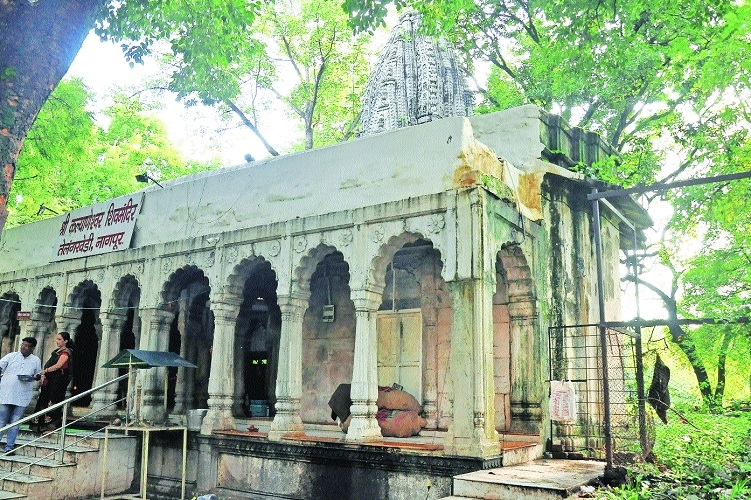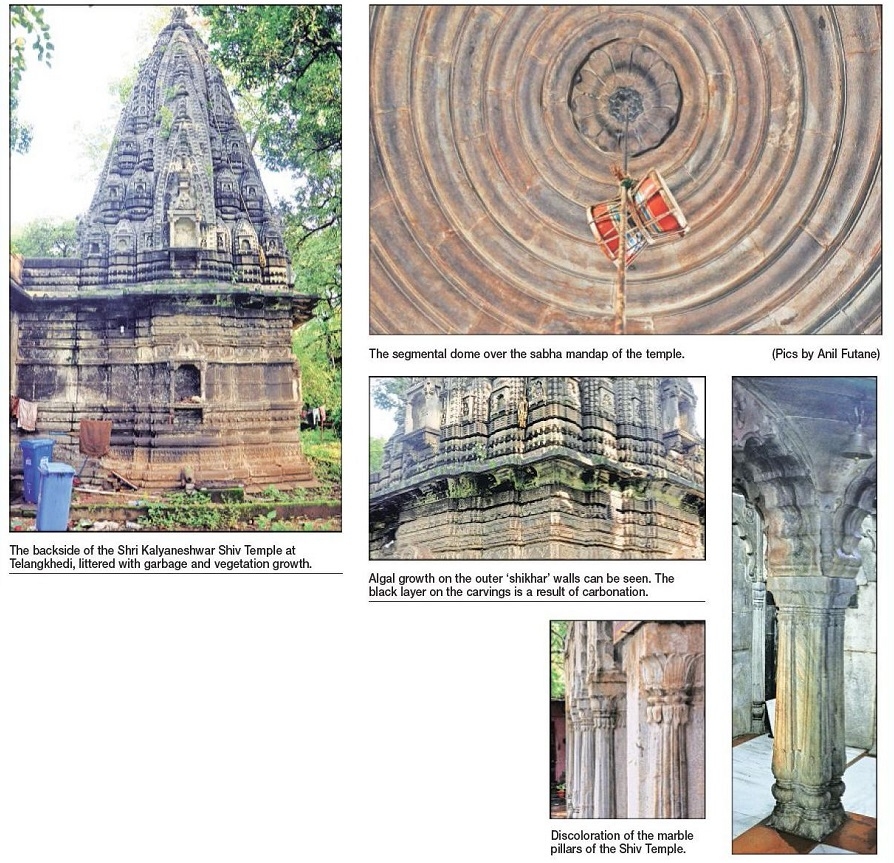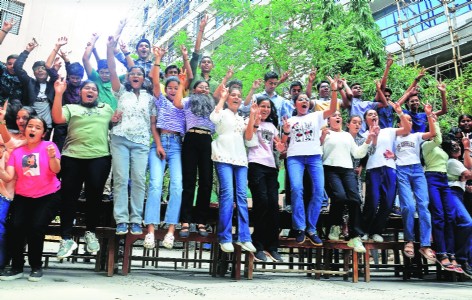Kalyaneshwar Shiv Temple: A silent narrator of heritage and faith
| Date :20-Aug-2023 |

Algal growth on the base and the outer walls of Kalyaneshwar Shiv Temple. (Pic by Anil Futane)
By Vaishnavi Pillay :
Heritage structures and religion have woven the fabric of human history and culture for centuries. Ancient temples of architectural value, beckon pilgrims and history enthusiasts alike. Tucked away in the serene area of Telangkhedi in Nagpur stands a piece of historical significance -- Shri Kalyaneshwar Shiv Temple -- carved by the hands of devotion and weathered by the winds of time, standing as a storyteller of history and faith.
It was constructed around the year 1785 by Raje Raghuji Bhonsle. However, some historians argue that it was built in 1794 by Chimabai, mother of Raje Raghuji Bhonsale.
It was a retreat centre for the Bhonsle family and all the activities there were managed by the Bhonsle Devasthan Trust until it
was bought by Shewalkar family in 1995. Now, it is the private property of Shewalkar family.
The status of the east-facing temple, listed as Grade-I structure due to its cultural and historical significance, is reported to be fair. It features ‘garbha gruha’ (sanctum sanctorum), ‘antralaya’ and ‘sabha mandap’ in stone masonry, constructed using basalt, sandstone and white marble. A small segmental dome over the ‘sabha mandap’ and a Nandi statue placed between the ‘antralaya’ and ‘sabha mandap’.

The ‘shikhar’ (top) displays carvings in the Orissan style, as cited by Dr Madhura Rathod, Associate Professor at Smt Manoramabai Mundle College of Architecture, Nagpur, and a Governing Council Member of Indian National Trust for Art and Cultural Heritage (INTACH), New Delhi.
While the temple emanates energy of spirituality, it also seeks attention for better conservation. The signs of neglect become apparent upon approach. Algal growth on its side walls and discoloration on the marble pillars are noticeable. Small shrubs have sprouted on the outer ‘shikhar’ walls, along with a disproportionate black layer on the carvings due to carbonation. The inner walls of the ‘garbha gruha’ have turned relatively black from continuous soot deposits. These conditions not only ruin the aesthetics but also pose a risk to the structure’s stability.
Dr Madhura Rathod emphasised that with timely conservation efforts and maintenance, the temple could be preserved for future generations to appreciate.
“The temple holds immense architectural value and cultural importance. Although the structure is in fair condition, with support of the Heritage Conservation Committee and co-operation from the owner, it is entirely possible to analyse the current state of the structure”, she asserted. She added, “If needed, a team from INTACH can willingly collaborate to guide the removal of unwanted layers seen on the walls”.
Paramjit Singh Ahuja, a conservation architect and environmental activist, told ‘The Hitavada’ that conservation of the city’s listed heritage sites, whether private or Government-owned, is the sole responsibility of Nagpur Municipal Corporation (NMC). “The temple’s overall condition is better than that of others, but it has been neglected for a long time. It can be well-maintained and conserved, which should not be a one-time affair but rather a regular practice”, he said.
According to him, it is not incumbent upon the owner to conserve it. NMC should seek guidance from experts and formulate conservation strategies, he added.
Another issue plaguing the temple is the lack of cleanliness in its surroundings. The backside of the temple is covered with overgrowth of unwanted vegetation and littered with garbage. It not only humiliates but also tarnishes the sacred ambience and, deters devotees from approaching the backside. The daily maintenance of the premises is done by the efforts of the small community of devotees. They work in their own way to look after the temple, but this does not seem to be enough.
Given the prevailing situation, the authorities concerned need to take note of the condition of the temple and initiate positive and constructive action to explore ways to conserve the temple’s legacy. For, any heritage site is a collective responsibility of the society.





